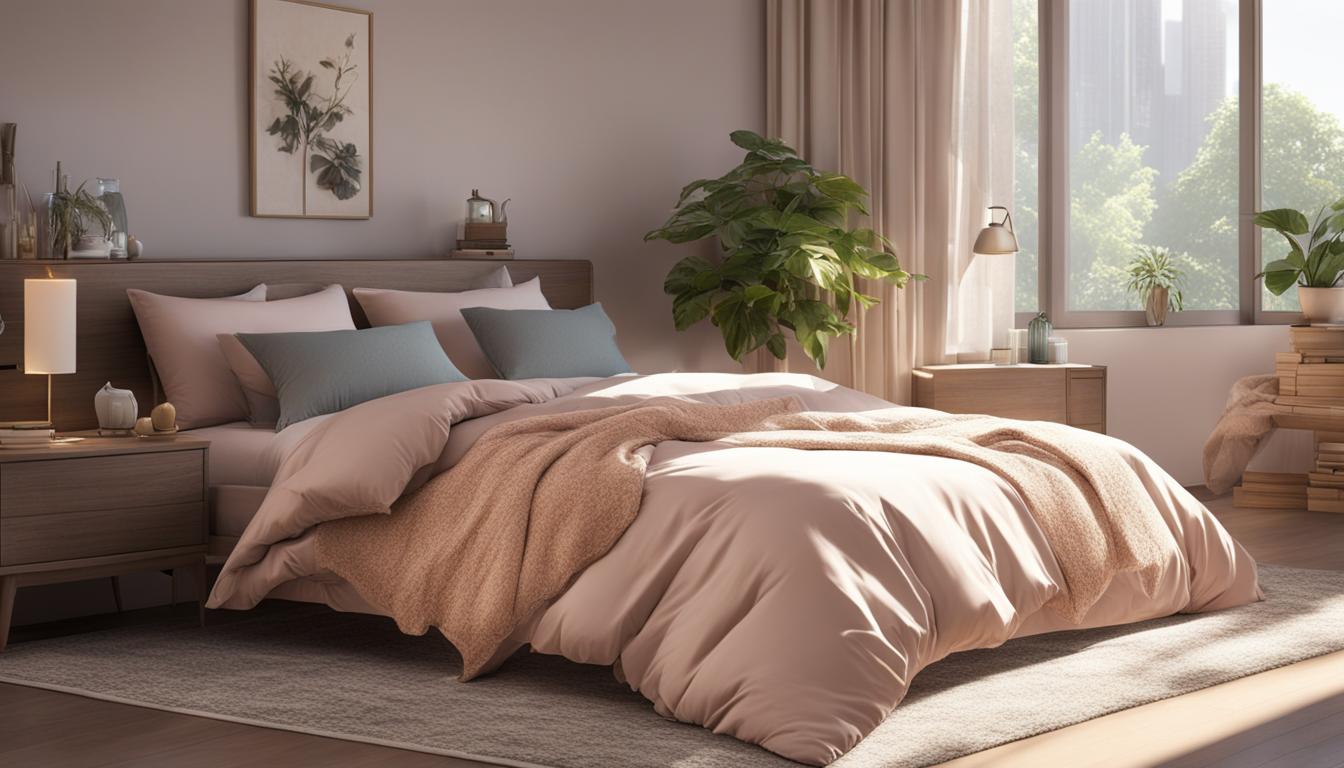Hypoallergenic Bedding Benefits That Will Transform Your Sleep!
Hypoallergenic Bedding Benefits That Will Transform Your Sleep!
Hypoallergenic Bedding Benefits! Hypoallergenic bedding offers a wide range of benefits that can greatly improve your sleep experience. Designed specifically to minimize allergic reactions and provide relief for individuals with sensitivities, hypoallergenic bedding is becoming increasingly popular for its health benefits and comfort.
Key Takeaways:
- Hypoallergenic bedding is designed to reduce the risk of allergic reactions and provide relief for individuals with sensitivities.
- It is made from natural fibers like TENCEL™ Lyocell, which naturally reduce the growth of bacteria and are free of harsh fragrances and chemicals.
- Hypoallergenic bedding is especially beneficial for individuals with allergies or sensitivities to dust mites, pet dander, and mold.
- Using hypoallergenic bedding can improve sleep quality, alleviate symptoms of allergies, asthma, and eczema, and create a healthier sleep environment.
- Investing in hypoallergenic bedding can result in better overall well-being and a more comfortable, allergy-free sleep experience.
Advantages of Hypoallergenic Bedding
Hypoallergenic bedding offers several advantages that can greatly improve your sleep quality and overall well-being. Here are some key benefits of choosing hypoallergenic bed sets:
- Allergen Reduction: Hypoallergenic bedding is designed to reduce exposure to common allergens such as dust mites, pet dander, and mold. By creating a barrier against these allergens, hypoallergenic bed linen provides relief for individuals with allergies or asthma, allowing for a more restful sleep.
- Clean Sleep Environment: Hypoallergenic bed sets help create a clean sleep environment by minimizing the presence of allergens. This is particularly beneficial for asthma patients, as it helps reduce triggers and promotes better respiratory health.
- Allergen-Resistant Components: Choosing hypoallergenic bed sets ensures that all bedding components, including sheets, pillowcases, and blankets, are allergen-resistant. This comprehensive approach ensures that your entire sleep surface is protected from allergens, enhancing your overall sleep experience.
With hypoallergenic bedding, you can enjoy a more comfortable and allergen-free sleep environment, resulting in improved sleep quality and a refreshed start to your day.
Table: Hypoallergenic Bedding Benefits
| Advantages | Description |
|---|---|
| Allergen Reduction | Hypoallergenic bedding reduces exposure to allergens like dust mites, pet dander, and mold, providing relief for individuals with allergies or asthma. |
| Clean Sleep Environment | Hypoallergenic bed sets create a clean sleep environment, minimizing the presence of allergens and promoting better respiratory health, especially for asthma patients. |
| Allergen-Resistant Components | Choosing hypoallergenic bed sets ensures that all bedding components are allergen-resistant, protecting your entire sleep surface from allergens. |
Health Benefits of Hypoallergenic Bedding

Using hypoallergenic bedding can provide numerous health benefits. By reducing exposure to allergens, such as dust mites and pet dander, hypoallergenic bedding can help alleviate symptoms of allergies, asthma, and eczema. It creates a healthier sleep environment, which can result in better sleep quality and improved overall well-being. Hypoallergenic bedding is especially beneficial for individuals with sensitive skin, as it is made from materials that are gentle and non-irritating.
Individuals with allergies often experience symptoms like sneezing, coughing, and itching, which can disrupt sleep and lead to daytime fatigue. By using hypoallergenic bedding, these symptoms can be minimized, allowing for a more restful and rejuvenating sleep. The hypoallergenic materials used in these bedding products create a barrier against common allergens, preventing them from penetrating the fabric and triggering allergic reactions.
For asthma patients, hypoallergenic bedding is particularly advantageous. Asthma symptoms can be triggered by dust mites, pet dander, and other allergens commonly found in bedding. By using hypoallergenic bedding, asthma patients can create a cleaner sleep environment, reducing the risk of asthma attacks and promoting better respiratory health. Hypoallergenic bedding can also benefit individuals with eczema, a condition characterized by inflamed and itchy skin. By minimizing exposure to allergens, hypoallergenic bedding can help soothe and protect sensitive skin, reducing eczema flare-ups.
The Benefits of Hypoallergenic Bedding for Better Sleep:
- Minimizes exposure to allergens
- Alleviates symptoms of allergies, asthma, and eczema
- Creates a healthier sleep environment
- Gentle and non-irritating for sensitive skin
Table: Comparison of Health Benefits
| Health Condition | Benefits of Hypoallergenic Bedding |
|---|---|
| Allergies | Reduces exposure to allergens, minimizes symptoms, improves sleep quality |
| Asthma | Creates a cleaner sleep environment, reduces asthma triggers, promotes better respiratory health |
| Eczema | Minimizes exposure to allergens, soothes and protects sensitive skin, reduces flare-ups |
| Sensitive Skin | Gentle and non-irritating materials, reduces skin irritation, enhances sleep comfort |
Investing in hypoallergenic bedding can transform your sleep experience and contribute to your overall well-being. By choosing bedding products that are free from harsh chemicals and allergens, you can create a sleep environment that promotes better sleep quality, reduces allergic reactions, and provides comfort for individuals with sensitive skin. Enjoy the health benefits of hypoallergenic bedding and wake up refreshed and rejuvenated every morning.
Dust Mite Resistant Bedding Perks
One of the main perks of hypoallergenic bedding is its dust mite resistant properties. Dust mites are microscopic insects that thrive in warm, humid environments like bedding. Hypoallergenic bedding is designed to prevent dust mites from entering or exiting the bedding, reducing allergic reactions caused by these pests. It uses hypoallergenic materials that create a barrier against dust mites and promote better sleep by minimizing the risk of allergen exposure.
To further illustrate the benefits of dust mite resistant bedding, we have prepared a comprehensive table:
| Hypoallergenic Bedding Features | Benefits |
|---|---|
| Dust mite resistant materials | Reduces risk of dust mite allergies and respiratory issues |
| Tightly woven fabric | Creates a barrier against dust mites and allergens |
| Easy to clean | Minimizes allergen buildup and promotes cleanliness |
| Hypoallergenic fillings | Provides additional protection against dust mites |
By investing in dust mite resistant bedding, you can enjoy a more restful sleep without the discomfort of allergies. The hypoallergenic materials in these bedding products ensure that you can sleep peacefully, knowing that you are protected from the allergens that may be present in traditional bedding. Improve your sleep quality and reduce allergic reactions with hypoallergenic bedding today.
Importance of Hypoallergenic Pillows

Hypoallergenic pillows play a crucial role in creating a hypoallergenic sleep environment. Traditional pillows can harbor allergens such as dust mites, pet dander, and mold, which can trigger allergies and respiratory issues. Using hypoallergenic pillows eliminates this risk and provides a clean and allergen-free sleeping surface. Additionally, hypoallergenic pillows are often accompanied by hypoallergenic mattress covers and pillow covers, further enhancing the benefits of a hypoallergenic sleep environment.
The Benefits of Hypoallergenic Pillows
- Allergen-free: Hypoallergenic pillows are specially designed to be resistant to allergens such as dust mites, pet dander, and mold. This ensures that you can sleep comfortably without the risk of triggering allergies or respiratory issues.
- Clean and hygienic: With their allergen-resistant properties, hypoallergenic pillows provide a clean and hygienic sleeping surface. They are made from materials that are less likely to accumulate dust, making them easier to clean and maintain.
- Enhanced comfort: Hypoallergenic pillows are crafted with the comfort of allergy-prone individuals in mind. They are generally made from soft and supportive materials that provide excellent neck and head support, promoting a more comfortable sleep experience.
When choosing hypoallergenic pillows, it is important to consider accompanying hypoallergenic mattress covers and pillow covers. These covers act as an additional barrier against allergens, preventing them from penetrating the pillow and mattress. Opting for hypoallergenic bedding components, including pillows, mattress covers, and pillow covers, can help create a complete hypoallergenic sleep environment, ensuring a healthier and more restful night’s sleep.
Table: Comparison of Hypoallergenic Pillow Options
| Pillow Type | Material | Allergen Resistance | Comfort Level |
|---|---|---|---|
| Memory Foam | Viscoelastic foam | High | Contoured support |
| Bamboo | Bamboo-derived rayon | High | Soft and breathable |
| Latex | Natural or synthetic latex | High | Firm and responsive |
| Down Alternative | Microfiber or polyester fill | Medium | Soft and plush |
Benefits of Natural Hypoallergenic Bedding
When it comes to hypoallergenic bedding, natural options offer a range of benefits that can enhance your sleep experience. Whether you choose bamboo, silk, wool, or a hypoallergenic down alternative, these natural materials provide unique advantages for individuals with allergies or sensitivities.
Bamboo hypoallergenic bedding stands out for its antimicrobial and moisture-wicking properties. It naturally repels allergens like dust mites and mold, creating a cleaner sleep environment. Additionally, bamboo fabric is soft, breathable, and eco-friendly, making it an excellent choice for those seeking both comfort and sustainability.
Silk hypoallergenic bedding offers a luxurious feel while being gentle on the skin. It is naturally hypoallergenic, non-irritating, and breathable, making it suitable for individuals with sensitive skin or allergies. Silk bedding can also regulate body temperature, keeping you cool in the summer and warm in the winter.
Hypoallergenic wool bedding provides natural insulation and is resistant to dust mites and mold. Wool is known for its ability to regulate temperature, keeping you comfortable throughout the night. It also wicks away moisture, preventing the growth of allergens and bacteria.
If you prefer the feel of down but want to avoid allergic reactions, hypoallergenic down alternative bedding is an excellent choice. It offers the same softness and comfort as down, but without the risk of allergens. Made from synthetic materials like microfiber or polyester, hypoallergenic down alternative bedding provides a plush and cozy sleep experience.
Benefits of Natural Hypoallergenic Bedding
| Material | Benefits |
|---|---|
| Bamboo | Antimicrobial, moisture-wicking, eco-friendly |
| Silk | Luxurious, gentle on the skin, regulates body temperature |
| Wool | Natural insulation, resistant to dust mites and mold, regulates temperature |
| Hypoallergenic Down Alternative | Soft and comfortable, allergen-free alternative to down |
Investing in natural hypoallergenic bedding can transform your sleep by providing a healthier and more comfortable sleep environment. Whether you choose bamboo, silk, wool, or a hypoallergenic down alternative, you can enjoy the benefits of allergy relief while indulging in the luxurious feel of high-quality bedding materials.
Hypoallergenic Bedding for Specific Conditions
Hypoallergenic bedding is not only beneficial for individuals with allergies or sensitivities in general, but it also offers specific advantages for those with certain conditions. Here’s a closer look at how hypoallergenic bedding can benefit individuals with asthma, sensitive skin, eczema, and children.
Hypoallergenic Bedding for Asthma Patients
Asthma patients often struggle with respiratory issues triggered by allergens in the environment. Hypoallergenic bedding plays a crucial role in creating a clean sleep environment to minimize the risk of asthma attacks. By reducing exposure to common allergens such as dust mites and pet dander, hypoallergenic bedding can help alleviate symptoms and promote better respiratory health.
Hypoallergenic Bedding for Sensitive Skin
Individuals with sensitive skin require bedding materials that are gentle and non-irritating. Hypoallergenic bedding is made from hypoallergenic fabrics that do not contain harsh chemicals or irritants, making it ideal for those with sensitive skin. These materials help prevent skin irritation, inflammation, and allergic reactions, allowing individuals to sleep comfortably and wake up without discomfort.
Hypoallergenic Bedding for Eczema Sufferers
Eczema is a skin condition characterized by dry, itchy, and inflamed skin. Hypoallergenic bedding can provide relief for individuals with eczema by minimizing exposure to allergens that can exacerbate the condition. The hypoallergenic materials used in bedding are less likely to irritate the skin and trigger flare-ups, helping individuals manage their eczema symptoms and improve their sleep quality.
Benefits of Hypoallergenic Bedding for Kids
Hypoallergenic bedding is highly recommended for children, especially those with allergies or sensitivities. Children are more vulnerable to allergens and may experience discomfort or respiratory issues when exposed to common triggers like dust mites and pet dander. Using hypoallergenic bedding for kids can reduce the risk of allergic reactions, provide a safe sleep environment, and promote better sleep quality for their overall well-being.
Investing in hypoallergenic bedding tailored to specific conditions can greatly improve the sleep experience and overall health of individuals with asthma, sensitive skin, eczema, and children. By minimizing exposure to allergens and providing a clean and comfortable sleep environment, hypoallergenic bedding plays a vital role in ensuring restful sleep and a healthier lifestyle.
Benefits of Microfiber Hypoallergenic Bedding

When it comes to allergy relief, microfiber hypoallergenic bedding offers numerous benefits. Made from synthetic materials with a tightly woven structure, microfiber bedding creates a barrier that prevents the entry of allergens such as dust mites and pet dander. This makes it an excellent choice for individuals with allergies or sensitivities, as it reduces the risk of allergic reactions and promotes a healthier sleep environment.
One of the key advantages of microfiber hypoallergenic bedding is its resistance to mold and mildew. These allergens can thrive in warm, moist environments, but with microfiber bedding, their growth is minimized. This helps to further alleviate allergy symptoms and provides a cleaner and more sanitary sleeping surface.
Another benefit of microfiber hypoallergenic bedding is its ease of maintenance. Microfiber materials are machine washable, making it simple to keep your bedding clean and free from allergens. Regular cleaning helps to eliminate dust mites, pet dander, and other potential triggers, ensuring a fresh and allergy-free sleep environment.
Lastly, microfiber hypoallergenic bedding offers the comfort and softness that is essential for a good night’s sleep. The smooth texture of microfiber provides a gentle and cozy feel, enhancing the overall sleep experience. It is also a durable and long-lasting choice, ensuring that your hypoallergenic bedding will continue to provide allergy relief for an extended period.
Comparative Benefits of Synthetic Hypoallergenic Bedding and Hypoallergenic Fleece Bedding
| Synthetic Hypoallergenic Bedding | Hypoallergenic Fleece Bedding | |
|---|---|---|
| Allergen Resistance | Excellent | Good |
| Warmth | Varies depending on the specific type of synthetic bedding | Excellent insulation |
| Softness | Varies depending on the specific type of synthetic bedding | Very soft and cozy |
| Durability | Durable and long-lasting | Durable and long-lasting |
| Hypoallergenic Properties | Highly effective in reducing allergen exposure | Effective in reducing allergen exposure |
Both synthetic hypoallergenic bedding and hypoallergenic fleece bedding provide benefits for individuals with allergies or sensitivities. Synthetic bedding offers excellent allergen resistance, making it an ideal choice for those who are prone to allergic reactions. Its warmth and softness can vary depending on the specific type of synthetic bedding, offering a range of options to suit individual preferences.
Hypoallergenic fleece bedding, on the other hand, provides excellent insulation and creates a cozy sleep environment. It is particularly well-suited for colder climates or individuals who prefer extra warmth during the night. While its allergen resistance may not be as high as synthetic bedding, hypoallergenic fleece still offers effective protection against common allergens.
Ultimately, the choice between synthetic hypoallergenic bedding and hypoallergenic fleece bedding comes down to personal preference and specific needs. Both options provide allergy relief and comfort, ensuring a restful night’s sleep without the worry of allergens.
Creating a Hypoallergenic Sleep Environment

When it comes to creating a hypoallergenic sleep environment, it’s important to consider not only the use of hypoallergenic bedding but also the choice of materials and maintenance practices. Hypoallergenic materials in bedding offer a range of benefits, from reducing allergen exposure to providing a comfortable sleep surface. One key aspect to focus on is the importance of washable hypoallergenic bedding. Regular cleaning helps maintain a clean sleep environment and eliminates allergens that can accumulate over time.
Using a hypoallergenic bed protector is another advantageous step in creating a hypoallergenic sleep environment. A bed protector acts as an additional barrier against allergens like dust mites and pet dander, preventing them from permeating the bedding and causing allergic reactions. By investing in a hypoallergenic bed protector, you can further enhance your protection against allergens and create a cleaner sleep surface.
Table: Hypoallergenic Bed Protector Advantages
| Advantages | Description |
|---|---|
| Allergen Barrier | The bed protector creates a barrier against allergens, such as dust mites and pet dander, reducing the risk of allergic reactions. |
| Ease of Cleaning | Most hypoallergenic bed protectors are machine washable, making it convenient to keep your sleep surface clean and allergen-free. |
| Mattress Protection | A bed protector also safeguards your mattress from stains, spills, and wear, prolonging its lifespan and maintaining its quality. |
By incorporating hypoallergenic materials in your bedding, utilizing washable hypoallergenic bedding, and employing a hypoallergenic bed protector, you can create a sleep environment that promotes better overall health and wellness. These measures work together to minimize allergen exposure, reduce the risk of allergic reactions, and provide a clean and comfortable space for a restful night’s sleep.
Conclusion – Hypoallergenic Bedding Benefits
Hypoallergenic bedding offers numerous benefits for individuals with allergies or sensitivities. These bedding products, made from hypoallergenic materials, provide relief from allergens like dust mites, pet dander, and mold, promoting better sleep quality and overall well-being. The advantages of hypoallergenic bedding include reducing allergic reactions, creating a clean sleep environment, and providing comfort.
Investing in anti-allergy bedding, such as hypoallergenic comforters and duvets, can transform your sleep experience. With hypoallergenic bedding, you can enjoy the peace of mind that comes with knowing your sleep environment is free from allergens that can disrupt your sleep or trigger allergic reactions.
Experience the comfort benefits of hypoallergenic duvets and the peace of mind that comes with choosing hypoallergenic bedding. Say goodbye to sleepless nights caused by allergies and embrace a healthier, allergy-free sleep environment with hypoallergenic bedding.
FAQ – Hypoallergenic Bedding Benefits
What is hypoallergenic bedding?
Hypoallergenic bedding refers to bedding products that are less likely to cause an allergic reaction. They are designed to be free of harsh fragrances and chemicals that can trigger dermatitis.
What are the advantages of using hypoallergenic bedding?
Hypoallergenic bedding reduces exposure to allergens like dust mites, pet dander, and mold, providing relief for individuals with allergies or asthma. It also helps create a clean sleep environment and promotes overall better sleep quality.
What health benefits does hypoallergenic bedding provide?
Using hypoallergenic bedding can help alleviate symptoms of allergies, asthma, and eczema by reducing exposure to allergens. It creates a healthier sleep environment, resulting in improved sleep quality and overall well-being.
What are the perks of dust mite resistant bedding?
Hypoallergenic bedding prevents dust mites from entering or exiting the bedding, reducing allergic reactions caused by these pests. It uses hypoallergenic materials that create a barrier against dust mites and promote better sleep by minimizing the risk of allergen exposure.
Why is hypoallergenic pillows important?
Traditional pillows can harbor allergens like dust mites, pet dander, and mold. Hypoallergenic pillows eliminate this risk and provide a clean and allergen-free sleeping surface. They are often accompanied by hypoallergenic mattress covers and pillow covers, further enhancing the benefits of a hypoallergenic sleep environment.
What are the benefits of natural hypoallergenic bedding?
Natural hypoallergenic bedding, such as bamboo, silk, wool, and down alternative, offers various advantages. Bamboo is naturally antimicrobial and moisture-wicking, silk is soft and gentle on the skin, wool provides natural insulation, and down alternative offers the luxurious feel of down without the risk of allergic reactions.
Who can benefit from hypoallergenic bedding?
Hypoallergenic bedding is beneficial for asthma patients, individuals with sensitive skin, and those suffering from eczema. It is also recommended for children as it reduces the risk of allergic reactions and provides a safe and comfortable sleep environment.
What are the benefits of microfiber hypoallergenic bedding?
Microfiber hypoallergenic bedding has a tightly woven structure that prevents the entry of allergens. It is highly resistant to mold and mildew, making it an excellent choice for individuals with allergies or sensitivities. Additionally, microfiber bedding is machine washable, making it easy to maintain cleanliness and eliminate allergens.
How can I create a hypoallergenic sleep environment?
Creating a hypoallergenic sleep environment involves using hypoallergenic bedding materials, washing bedding regularly, and using a hypoallergenic bed protector. These measures work together to create an optimal sleep environment for individuals with allergies or sensitivities.




